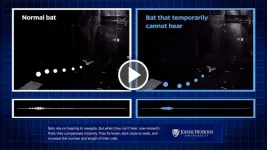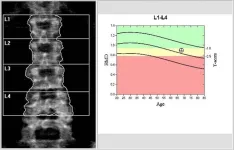(Press-News.org) When bats can’t hear, new research finds that these hearing-dependent animals employ a remarkable compensation strategy.
They adapt immediately and robustly, suggesting for the first time that bats’ brains are hard-wired with an ability to launch a Plan B in times of diminished hearing.
The Johns Hopkins University work, newly published in Current Biology, raises questions about whether other animals and even humans might be capable of such deft accommodations.
“Bats have this amazing flexible adaptive behavior that they can employ anytime,” said senior author Cynthia F. Moss, a Johns Hopkins neuroscientist who studies bats. “Other mammals and humans also have these adaptive circuits that they can use to help make decisions and navigate their environment but what’s striking here is that it’s very fast, almost automatic.”
All animals adapt in various ways as a response to sensory deprivation. People at a loud bar, might lean in to better hear what someone is saying. A dog might tilt its head toward a muted sound.
Here researchers wondered how hearing-dependent echolocating bats might adapt when a key auditory region in the brain was turned off.
They trained bats to fly from a platform, down a corridor, and through a window to get a treat. Researchers then had the same bats repeat the task but with a critical auditory pathway in the midbrain temporarily blocked. Disabling this brain region isn’t like plugging your ears; it’s preventing most auditory signals from reaching the deep brain. The drug-induced technique is reversible and lasts about 90 minutes.
With their hearing blocked, bats were able to navigate the course surprisingly well, even on the first try. They weren’t as agile and ran into things, but every tested bat compensated immediately and effectively.
“They struggled but managed,” Moss said.
The bats changed their flight path and vocalizations. They flew lower, oriented themselves along walls and increased both the number and length of their calls, which boosted the power of echo signals they use for navigation.
“Echolocation acts like strobes, so they were basically taking more snapshots to help them get the missing information,” said co-author Clarice A. Diebold, a former Johns Hopkins graduate student who is now a postdoctoral student at Washington University in St. Louis. “We also found that they broadened the bandwidth on these calls. These adaptations are very interesting because we’d usually see them when bats are compensating for external noise but this is an internal processing deficit.”
Although the team repeated the experiments, the compensation skills of the bats didn’t improve over time. This means the adaptation behaviors the bats employed weren’t learned; they were innate, latent and hard-wired into the bats’ brain circuitry.
“It highlights how robust the brain is to manipulation and external noise,” said co-author Jennifer Lawlor, a postdoctoral fellow at Johns Hopkins.
The team was surprised that the bats could hear at all with this region of their brain disabled. They believe bats either relied on a previously unknown auditory pathway or that unaffected neurons might support hearing in previously unknown ways.
“You’d think an animal wouldn’t be able to hear at all,” Moss said. “But it suggests that there might be multiple pathways for sound to travel to the auditory cortex.”
The team would next like to determine to what degree the findings apply to other animals and humans.
“Can this work tell us something about auditory processing and adaptive responses in humans? Moss said. “Since no one has done this, we don’t know. The findings raise important questions that will be exciting to pursue in other research models.”
Authors include Kathryne Allen, Grace Capshaw, Megan G. Humphrey, Diego Cintron-De Leon and Kishore V. Kuchibhotla, all of Johns Hopkins.
END
Bats’ amazing plan B for when they can’t hear
New research reveals instant compensation strategy that other animals might share
2024-11-25
ELSE PRESS RELEASES FROM THIS DATE:
Common thyroid medicine linked to bone loss
2024-11-25
CHICAGO – Levothyroxine, the second most commonly prescribed medication among older adults in the U.S., may be associated with bone loss, according to a study being presented next week at the annual meeting of the Radiological Society of North America (RSNA).
Levothyroxine, marketed under multiple brand names including Synthroid, is a synthetic version of a hormone called thyroxine and is commonly prescribed to treat the condition hypothyroidism, or underactive thyroid. In people with hypothyroidism, the thyroid gland does not produce enough thyroxine on its own, often resulting in fatigue, weight gain, hair loss and other symptoms. If left untreated, hypothyroidism ...
Vaping causes immediate effects on vascular function
2024-11-25
CHICAGO – Researchers have identified acute effects of cigarette and e-cigarette smoking on vascular function, even without nicotine. The results of the ongoing research are being presented next week at the annual meeting of the Radiological Society of North America (RSNA).
E-cigarettes, also known as vapes, are battery-operated devices that heat a liquid to produce an aerosol, which is then inhaled into the lungs. Vapes contain significantly fewer chemicals and toxins than are found in tobacco smoke. As a result, e-cigarettes are believed by many to be less harmful than cigarette smoking. Vapes also come in various flavors, making them popular among young people.
“E-cigarettes ...
A new clock to structure sleep
2024-11-25
Researchers at the University of Lausanne have identified a novel role for the brain’s ‘locus coeruleus’ in sleep and its disruptions. This brain region facilitates the transition between NREM and REM sleep states while maintaining an unconscious vigilance toward the external world. Stress disrupts its functions and negatively impacts on sleep quality.
Sleep disorders affect an increasing number of people, with potentially serious consequences for their health. Mammalian sleep consists of cycles between two states: non-rapid eye movement (NREM) sleep and rapid eye ...
Study reveals new way to unlock blood-brain barrier, potentially opening doors to treat brain and nerve diseases
2024-11-25
New York, NY [November 25, 2024]—Researchers at the Icahn School of Medicine at Mount Sinai have developed an innovative approach—demonstrated in mouse models and isolated human brain tissue—to safely and effectively deliver therapeutics into the brain, providing new possibilities for treating a wide range of neurological and psychiatric diseases.
Published in the November 25 online issue of Nature Biotechnology [https://doi.org/10.1038/s41587-024-02487-7], the study introduces a first-of-its-kind blood-brain barrier-crossing conjugate (BCC) system, designed to overcome the protective barrier that typically blocks large biomolecules from ...
Viking colonizers of Iceland and nearby Faroe Islands had very different origins, study finds
2024-11-25
The ancient Vikings certainly had the travel bug. Between the late eighth century and approximately 1050 CE, they roamed the Atlantic in their longships all the way to Newfoundland, Labrador, and Greenland, as well as exploring the Mediterranean and continental Eurasia.
Among the places the Vikings are known to have settled were the Faroe Islands, an archipelago of 18 islands in the North Atlantic. They probably weren’t the first to do so: archaeologists have found evidence that these islands had been inhabited since approximately 300 CE, possibly ...
One in 20 people in Canada skip doses, don’t fill prescriptions because of cost
2024-11-25
Affordability in Canada affects not just groceries but also medications, with 1 in 20 people unable to take their medications as prescribed because of cost, found new research published in CMAJ (Canadian Medical Association Journal) https://www.cmaj.ca/lookup/doi/10.1503/cmaj.241024.
Prescription medications are not universally covered under Canada’s 13 provincial and territorial health insurance systems. In 2021, Canadian households paid more than $7.4 billion out of pocket for prescription medications.
The study, which included a nationally representative ...
Wildlife monitoring technologies used to intimidate and spy on women, study finds
2024-11-25
Remotely operated camera traps, sound recorders and drones are increasingly being used in conservation science to monitor wildlife and natural habitats, and to keep watch on protected natural areas.
But Cambridge researchers studying a forest in northern India have found that the technologies are being deliberately misused by local government and male villagers to keep watch on women without their consent.
Cambridge researcher Dr Trishant Simlai spent 14 months interviewing 270 locals living around the Corbett Tiger Reserve, a national park in northern India, including many women from nearby villages.
His report, published today in the journal Environment and Planning ...
Around 450,000 children disadvantaged by lack of school support for color blindness
2024-11-24
Around 450,000 children are being failed by the UK education system because they have a special educational need and disability (SEND) that is effectively unrecognised by most schools and local education authorities, an author has warned.
Supporting Colour Blindness in Education and Beyond, by author Marie Difolco, shines a spotlight on a commonly-overlooked SEND in modern classrooms: colour blindness (also known as colour vision deficiency, or CVD). She also warns that many myths surround this condition, with many people believing it just means not being able to tell the ...
Reality check: making indoor smartphone-based augmented reality work
2024-11-23
Osaka, Japan – Smartphone-based augmented reality, in which visual elements are overlaid on the image of a smartphone camera, are extremely popular apps. These apps allow users to see how furniture would look in their house, or navigate maps better, or to play interactive games. The global phenomenon Pokémon GO, which encourages players to catch digital creatures through their phone, is a well-known example.
However, if you want to use augmented reality apps inside a building, prepare to lower your expectations. ...
Overthinking what you said? It’s your ‘lizard brain’ talking to newer, advanced parts of your brain
2024-11-22
Study sought to better understand how humans evolved to become skilled at thinking about others
Newer parts of the brain that support social interactions are connected to and in constant communication with the ancient amygdala
First study to map with fMRI never-before-seen details of the brain’s social cognitive network
CHICAGO --- We’ve all been there. Moments after leaving a party, your brain is suddenly filled with intrusive thoughts about what others were thinking. “Did they think I talked too much?” “Did my joke offend them?” “Were ...
LAST 30 PRESS RELEASES:
Heart-brain connection: international study reveals the role of the vagus nerve in keeping the heart young
Researchers identify Rb1 as a predictive biomarker for a new therapeutic strategy in some breast cancers
Survey reveals ethical gaps slowing AI adoption in pediatric surgery
Stimulant ADHD medications work differently than thought
AI overestimates how smart people are, according to HSE economists
HSE researchers create genome-wide map of quadruplexes
Scientists boost cell "powerhouses" to burn more calories
Automatic label checking: The missing step in making reliable medical AI
Low daily alcohol intake linked to 50% heightened mouth cancer risk in India
American Meteorological Society announces Rick Spinrad as 2026 President-Elect
Biomass-based carbon capture spotlighted in newly released global climate webinar recording
Illuminating invisible nano pollutants: advanced bioimaging tracks the full journey of emerging nanoscale contaminants in living systems
How does age affect recovery from spinal cord injury?
Novel AI tool offers prognosis for patients with head and neck cancer
Fathers’ microplastic exposure tied to their children’s metabolic problems
Research validates laboratory model for studying high-grade serous ovarian cancer
SIR 2026 delivers transformative breakthroughs in minimally invasive medicine to improve patient care
Stem Cell Reports most downloaded papers of 2025 highlight the breadth and impact of stem cell research
Oxford-led study estimates NHS spends around 3% of its primary and secondary care budget on the health impacts of heat and cold in England
A researcher’s long quest leads to a smart composite breakthrough
Urban wild bees act as “microbial sensors” of city health.
New study finds where you live affects recovery after a hip fracture
Forecasting the impact of fully automated vehicle adoption on US road traffic injuries
Alcohol-related hospitalizations from 2016 to 2022
Semaglutide and hospitalizations in patients with obesity and established cardiovascular disease
Researchers ‘listen in’ to embryo-mother interactions during implantation using a culture system replicating the womb lining
How changing your diet could help save the world
How to make AI truly scalable and reliable for real-time traffic assignment?
Beyond fragmented markets: A new framework for efficient and stable ride-pooling
Can shape priors make road perception more reliable for autonomous driving?
[Press-News.org] Bats’ amazing plan B for when they can’t hearNew research reveals instant compensation strategy that other animals might share









